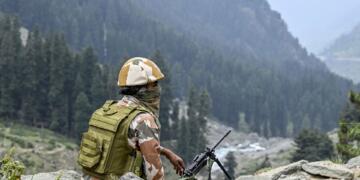In eastern Ladakh, it is bad news for Beijing as the team that gave a bloody nose to China during Doklam stand-off in 2017 is back in business. China’s nose is set to get bloodier at eastern Ladakh in 2020 as the three men of the ‘Doklam team’ are at the helm of affairs all over again.
Prime Minister Modi chaired a high-level meeting regarding the soaring tensions in Ladakh on Tuesday. Three men- National Security Adviser Ajit Doval, Chief of Defence Staff General Bipin Rawat and Foreign Minister S. Jaishankar, comprising the ‘Doklam team’ too attended this meeting.
Ajit Doval was the NSA even at the time of Doklam stand-off, while Jaishankar has grown in stature from India’s Foreign Secretary to Foreign Minister and General Rawat too enjoys more importance in 2020 as the CDS than he enjoyed as the Army Chief in 2017.
At this meeting it was decided that India won’t allow Beijing to alter the status quo at the Line of Actual Control (LAC) and the Chinese troops build-up will be dealt with “strength and restraint”.
The ‘Doklam team’ will be leading India’s response to Chinese aggression at eastern Ladakh, even as the Indian Army troops stand up to the Chinese troop build up and match up to the People’s Liberation of Army’s (PLA) aggression.
The Ladakh situation is slightly more tense than the 73-day Doklam stand-off in 2017, but there are several trappings between the two incidents. And in this sense, the ‘Doklam team’ getting pressed into service all over again is bad news for China.
The Doklam stand-off had started on June 16, 2017 after India objected to Chinese troops entering the Doklam plateau in Bhutan’s territory to build a road. The Indian troops dug in and stood up to Chinese aggression during a 73-day long stand-off between the armies of the two countries. Ultimately the Chinese troops had to give in as the ‘Doklam team’ gave a bloody nose to the PLA.
What is currently happening in eastern Ladakh around bears stark similarity to the 2017 stand-off in Doklam. Beijing wants India to stall its infrastructure project in the Daulat Beg Oldie (DBO) sector.
Hindustan Times has quoted a national security planner in the government as saying, “The Darbuk-Shyok-DBO road will be completed this year and will raise the Indian capacity to rapidly deploy in the area. If the road project is blocked, the Indian Army will be forced to live off aerial supply lines and prepare for an arduous route linking Sansoma to Murgo to DBO through glaciated Saser La.”
The message from Tuesday’s meeting is similar to India’s response during the Doklam stand-off in 2017. While India favours de-escalation through mutual respect and dialogue through established bilateral mechanisms between India and China, the ‘Doklam team’ has been asked to prepare for all eventualities.
The DBO road project is critical to India’s strategic position in the region, and this Summer is China’s last opportunity to stall it.
With extensive troops deployment of around 5,000 soliders, China is trying to pressurise India into giving in to China’s bullying. Beijing had also tried to use a bellicose narrative during the Doklam stand-off to weigh down India, but the three men on India’s side has stood up firmly to Chinese aggression.
This time around too, New Delhi has responded by deploying more troops in the concerned theatre and helming India’s plans to thwart Chinese aggression.
China wanted to cut India to size, what it didn’t factor in was that the three men who gave it a bloody nose in Doklam in 2017 are at the helm of India’s security establishment now. The ‘Doklam team’ has come together yet again and they are ready to make China’s nose bloodier.


































